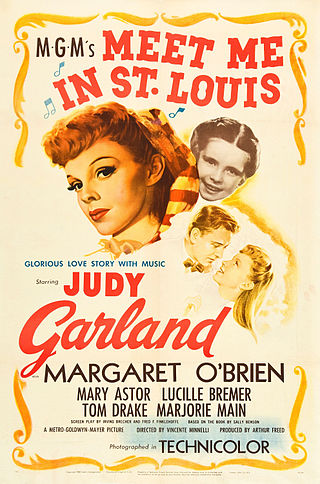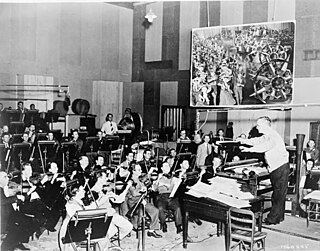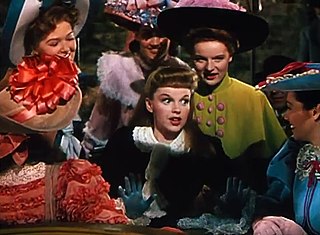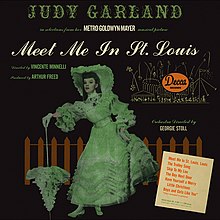
Meet Me in St. Louis is a 1944 American Christmas musical film made by Metro-Goldwyn-Mayer. Divided into a series of seasonal vignettes, starting with Summer 1903, it relates the story of a year in the life of the Smith family in St. Louis leading up to the opening of the Louisiana Purchase Exposition in the spring of 1904. The film stars Judy Garland, Margaret O'Brien, Mary Astor, Lucille Bremer, Tom Drake, Leon Ames, Marjorie Main, June Lockhart and Joan Carroll.
Gordon Hill Jenkins was an American arranger, composer, and pianist who was influential in popular music in the 1940s and 1950s. Jenkins worked with The Andrews Sisters, Johnny Cash, The Weavers, Frank Sinatra, Louis Armstrong, Judy Garland, Nat King Cole, Billie Holiday, Harry Nilsson, Peggy Lee and Ella Fitzgerald.
"Have Yourself a Merry Little Christmas" is a song written in 1943 by Hugh Martin and Ralph Blane and introduced by Judy Garland in the 1944 MGM musical Meet Me in St. Louis. Frank Sinatra later recorded a version with modified lyrics. In 2007, ASCAP ranked it the third most performed Christmas song during the preceding five years that had been written by ASCAP members. In 2004 it finished at No. 76 in AFI's 100 Years...100 Songs rankings of the top tunes in American cinema.
Hugh Martin was an American musical theater and film composer, arranger, vocal coach, and playwright. He was best known for his score for the 1944 MGM musical Meet Me in St. Louis, in which Judy Garland sang three Martin songs, "The Boy Next Door", "The Trolley Song", and "Have Yourself a Merry Little Christmas". The last of these has become a Christmas season standard in the United States and around the English-speaking world. Martin became a close friend of Garland and was her accompanist at many of her concert performances in the 1950s, including her appearances at the Palace Theater.
"On the Atchison, Topeka and the Santa Fe" is a popular song written by Harry Warren with lyrics by Johnny Mercer. The song was published in 1944, spanned the hit chart in mid-1945, and won the 1946 Academy Award for Best Original Song, the first win for Mercer.
"The Christmas Song" is a classic Christmas song written in 1945 by Robert Wells and Mel Tormé.
"My Dreams Are Getting Better All the Time" is a 1945 popular song.
"Pennies from Heaven" is a 1936 American popular song with music by Arthur Johnston and lyrics by Johnny Burke. It was introduced by Bing Crosby with Georgie Stoll and his Orchestra in the 1936 film of the same name.

The songs from the 1939 musical fantasy film The Wizard of Oz have taken their place among the most famous and instantly recognizable American songs of all time, and the film's principal song, "Over the Rainbow", is perhaps the most famous song ever written for a film. Music and lyrics were by Harold Arlen and E.Y. "Yip" Harburg, who won an Academy Award for Best Song for "Over the Rainbow."

"The Trolley Song" is a song written by Hugh Martin and Ralph Blane and made famous by Judy Garland in the 1944 film Meet Me in St. Louis. In a 1989 NPR interview, Blane said the song was inspired by a picture of a trolleycar in a turn-of-the-century newspaper. In 1974, he had said the picture was in a book he had found at the Beverly Hills Public Library and was captioned "'Clang, Clang, Clang,' Went the Trolley."

Merry Christmas is a compilation album by Bing Crosby that was released in 1945 on Decca Records. It has remained in print through the vinyl, CD, and downloadable file eras, currently as the disc and digital album White Christmas on MCA Records, a part of the Universal Music Group, and currently on vinyl as Merry Christmas on Geffen Records. It includes Crosby's signature song "White Christmas", the best-selling single of all time with estimated sales of over 50 million copies worldwide. The album was certified 4× Platinum by RIAA for selling over 4 million copies in United States. The original 1945 release and subsequent re-releases and re-packages spent a total of 39 weeks at no. 1 on the Billboard pop albums chart.
"The Boy Next Door" is a 1944 popular song by Hugh Martin and Ralph Blane. It was introduced in the musical film Meet Me in St. Louis, where it was performed by Judy Garland to an arrangement of Conrad Salinger conducted by Georgie Stoll. It has been praised as a perfect example of how to advance story and reveal a character’s emotions efficiently on screen.

Judy Garland signed her first recording contract at age 13 with Decca Records in late 1935. Garland began recording albums for Capitol Records in the 1950s. Her greatest success, Judy at Carnegie Hall (1961), was listed for 73 weeks on the Billboard 200 chart, was certified Gold, and took home five Grammy Awards.

"I'm Always Chasing Rainbows" is a popular Vaudeville song. The music is credited to Harry Carroll, but the melody is adapted from Fantaisie-Impromptu by Frédéric Chopin. The lyrics were written by Joseph McCarthy, and the song was published in 1917. It was introduced in the Broadway show Oh, Look! which opened in March 1918. The song was sung in the show by the Dolly Sisters. Judy Garland sang it in the 1941 film Ziegfeld Girl. It was subsequently sung by Jack Oakie in the 1944 film The Merry Monahans and was again featured in the 1945 film The Dolly Sisters, where it was sung by John Payne. It was also included for part of the run of the 1973 revival of Irene.
Georgie Stoll was a musical director, conductor, Academy Award-winning composer, and jazz violinist, associated with the Golden Age of Metro-Goldwyn-Mayer musicals and performers from the 1940s to 1960s. He was also later credited as George E. Stoll.
"Among My Souvenirs" is a 1927 song with words by Edgar Leslie and music by Horatio Nicholls.

"I'll Be Home for Christmas" is a Christmas song written by the lyricist Kim Gannon and composer Walter Kent and recorded in 1943 by Bing Crosby, who scored a top ten hit with the song. Originally written to honor soldiers overseas who longed to be home at Christmas time, "I'll Be Home for Christmas" has since gone on to become a Christmas standard.
This is a list of Bing Crosby songs he recorded twice or more during his career, excluding all of the 1954 re-recordings for Bing: A Musical Autobiography.

Bing Crosby Sings with Judy Garland, Mary Martin, Johnny Mercer is a Decca Records compilation album of phonograph records by Bing Crosby, Judy Garland, Mary Martin and Johnny Mercer.

Christmas Greetings is a studio album of phonograph records by Bing Crosby released in 1949 featuring popular Christmas songs.










